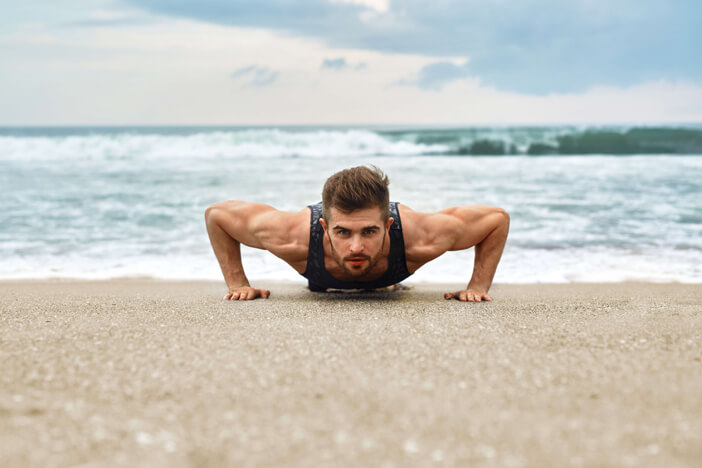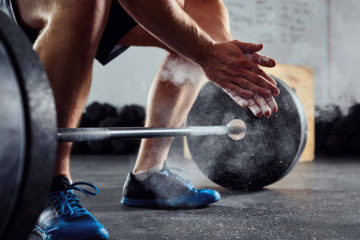Burpees - a full-body exercise

Burpees: Targeted muscle groups
Whole body: large muscle groups such as chest, abdomen, back and thigh muscles and small muscle groups such as shoulder and arm muscles
Do you want to learn how to integrate burpees into your training and how to make your training more effective? Then take a look at our pages about chest training, back training, abdominal training and leg training.
The correct execution of burpees
A burpee is a combination of a squat, a push-up and a jump. Start in a hip-width stance then crouch low and support yourself on the floor with your hands in front of your feet (your hands should be shoulder-width apart). Now jump backwards into a push-up position and start your first push-up. Then jump forward again with your feet so that you are squatting again. Last but not least, do a stretching jump upwards.
Weight recommendations for Burpees

You only need your own body weight.
Equipment for Burpees
No equipment is necessary.
Variations of Burpees

Half Burpees
This is the same as a normal burpee, but without the push-up.
Double Burpees
Here you repeat every step twice: 2x squats, 2x backward jumps, 2x push-ups, 2x forward jumps, 2x stretching jumps.
Box Jump Burpee
For this you will need a box or a bench at a suitable height for you. Instead of the upward jump at the end, you jump on the box. Afterwards, you jump off the box/bench and repeat the exercise again.
One legged Burpees
Here you perform each part of the burpee with one leg. This works the leg muscles even harder and is an effective leg training.
Burpees with hand claps
Increase the level of difficulty by clapping your hands as you are coming up from your pushup. In this variation, your arms, back and chest muscles are particularly stimulated by pushing your body away from the floor to clap. You can build this variation into your back training or chest training.
Burpees with forearm support
If the push-ups are too challenging for you, you can exchange them for a forearm support. You do this by going onto your hands briefly and then your elbows.
Typical mistakes with Burpees

- Dropping down: don’t just drop into the pushups and squats. Keep your muscle tension and go down in a controlled manner.
- Crooked back: avoid a crooked back in the squatting position. This is a sign of a lack of tension in your torso muscles.
- Sagging hips: many athletes let their hips sag, especially when doing push-ups. This should be avoided – your body should form a straight line.
- Forgetting to breathe: exhale during the jumps and the concentric phase of the pushups and inhale in between. Find your own rhythm. It is important not to hold your breath before exertion.
In which training schedules do burpees appear?
You can build burpees into any training. They are also perfect as a warm-up exercise. If you want to learn more about training different parts of your body, take a look at our pages about back training, chest training, abdominal training or leg training and get the most out of your workout.
Frequently asked questions and answers
Whole body: large muscle groups such as the chest, abdomen, back and thigh muscles and small muscle groups such as the shoulder and arm muscles
- Half Burpee: This is a normal Burpee, but without the push-up element.
- Double Burpee: Here you repeat every step twice, that means: 2x squats, 2x backward jumps, 2x push-ups, 2x forward jumps, 2x upward jumps.
- Box Jump Burpee: For this you need a box or a bench at a height that is suitable for you. Instead of doing the upward jump at the end, you jump onto the box. Afterwards you jump off the box/bench and repeat the exercise again.
- One-legged burpee: Here you perform each part of the burpee on one leg.
- Burpees with hand claps: Increase the difficulty by clapping your hands once as you come up from your pushups.
- Burpee with forearm support: If the pushups are too difficult for you, exchange them for a forearm support, whereby you briefly go onto your hands and then onto your elbows.
A burpee is a combination of a squat, a push-up and an upward stretching jump. You start with a hip-width stance then crouch low and support yourself on the floor with your hands before your feet. Your hands should be in a shoulder-wide position. Then jump backwards into a push-up position and start your first push-up. Next jump forwards again with your feet so that you are squatting again. Last but not least, do the upward stretching jump.



